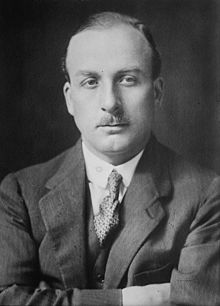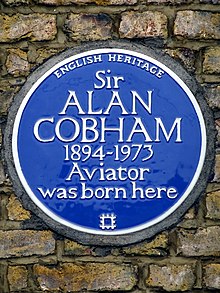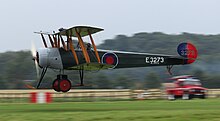Alan Cobham
Sir Alan John Cobham , KBE (born May 6, 1894 in Southwark , London , England , † October 21, 1973 in Bournemouth , England) was a British aviation pioneer and entrepreneur.
Life
Early years
Sir Alan Cobham was born on May 6, 1894 in the Peckham borough of Southwark , London . In the neighboring district of Camberwell he attended Wilson's School from 1904 to 1909. He left them at the age of 15 and began training in 1909 at Hitchcock, Williams & Co , a global wholesaler. Almost four years later he broke off his training and moved to Donald Birchley, a cousin of his father, in Brockbury Hall in Herefordshire , about 60 km south of Birmingham, to work as a farmer. There he also gained his first veterinary experience.
Time in the military
With the outbreak of World War I in 1914, Alan Cobham volunteered for the military on August 14, 1914 and was responsible for horses in the Royal Field Artillery due to his knowledge of horses and sheep. As a result, he became Staff Veterinary Sergeant, which corresponds to the staff veterinarian in Germany . After he was stationed in France and, among other things, took over the duties of a staff officer, he made the decision in November 1917 to apply to the Royal Flying Corps, where he was also accepted. In May of the following year he finally began to take flight lessons and after completing his first solo flight with a DH6 in June , he was employed as a flight instructor from August.
Entrepreneurial activity
In May 1919 he founded the Berkshire Aviation Company with Fred and Jack Holmes , which offered sightseeing flights in various locations in England. Cobham flew an Avro 504 , with a second aircraft added later. It was a novelty to most people at the time, and Cobham and the Holmes brothers brought aviation closer to the population. At Easter the following year, however, they ended the partnership, as the financial support they had received up until then was no longer continued.
A short time later he applied to the Aircraft Manufacturing Company (Airco) , which was active in aerial photography . There he worked again as a pilot. However, Airco also went bankrupt and Geoffrey de Havilland , who worked as chief designer in the company from 1914, took over the company in September 1920 and renamed it De Havilland Aircraft Company . A year later, this company also took over all photography flights for the Aerofilms group , which bought the aerial photography division of Airco. At the same time Cobham moved to De Havilland .
At De Havilland , he initially continued to accompany aerial photographers to fly them to the objects throughout England. He was also responsible for charter flights that took him to various cities in Europe. One of the most famous flights took place on June 28, 1922, just two days before his wedding to Gladys Lloyd. He was supposed to fly to Dublin to the riots breaking out there on behalf of the Times to pick up photos. In the issue on the following day, in addition to the photos, a text was printed by him in which he described the trip. In 1924/25 de Havilland designed and built the de Havilland DH.60 , also known under the name Moth . The Moth was the predecessor to the Tiger Moth, which was used successfully as a training aircraft around the world. Cobham flew the 1,600 km from Croydon near London to Zurich and back in one day with the prototype of a DH60 . That brought the model and De Havilland significant attention.
In 1931 Cobham was one of the founding members of Airspeed Ltd. There he was involved in experiments on air refueling . To this end, he founded Flight Refueling Ltd. in 1934 . (FRL), which used an Airspeed Courier converted for this purpose . The company exists today under the name Cobham plc and is a supplier and developer for electronic components and air refueling systems in the aviation industry. Cobham handed over management of the company to his son in 1969 and retired to the British Virgin Islands , but then returned to England and died in Bournemouth in 1973.
Long haul flights

Europe and North Africa
With the American Lucien Sharpe he flew in various stages through large parts of Europe from 1921 onwards. In August they started in Paris and flew via Brussels, Hamburg, Stockholm, Berlin and Prague to Venice, among others. After three weeks they reached Paris again via Italy and France. In December it went again via France to Spain and then on to North Africa. There they drove to Casablanca and Rabat and back they went via Italy. After a crash landing, the tour ended in Venice in February. In total, they covered 8,000 km.
India
On November 20, 1924, Alan Cobham took off for Karachi, India, with Sir Sefton Brancker, head of civil aviation in England. They reached Karachi ten days later via Berlin, Bucharest, Turkey and Baghdad. From February 28 to March 17, 1925, they flew back a very similar route.
Africa
Together with Elliot, his mechanic, and the photographer Emmett, Cobham set off for Cape Town on November 15, 1925. Via Paris and Sallum in the northwest of Egypt it went to Cairo, Johannesburg and then to Cape Town. On February 26th, they returned the same route until they finally reached London again on March 13th, 1926. A short time later, the book My Flight to the Cape and Back, written by Alan Cobham about this flight, was published .
Australia
In order to bring the subject of civil aviation closer to the parliament in London, Cobham planned to land on the Thames in a seaplane in London and thus to hand over a petition as publicly as possible. To increase the effect, he wanted to make a long-haul flight to Australia and back. To do this, he converted the DH50, with which he had already been to India and Africa, so that it was now equipped with floats. Just a few weeks after his arrival from Africa, he started with Elliot on June 30, 1926 to reach Naples, the goal of the first stage, before dark. The two passed Athens and Baghdad. Between Baghdad and Basra in southern Iraq, Elliot was shot by a local and lost his life shortly afterwards. Cobham continued the journey a few days later with Ward, an Air Force mechanic. After Calcutta and Singapore, they reached Melbourne on August 15, 1926. Two weeks later they flew back to London from there, where they landed on October 1st.
Works
- Sir Alan Cobham KBE: Australia and Back A. & C. Black Ltd., London 1926
- Alan J. Cobham: My Flight to the Cape and Back A. & C. Black Ltd., London 1926
- Sir Alan Cobham: Twenty-thousand Miles in a Flying Boat Tempus Publishing, Stroud first edition: 1930 ISBN 978-0-7524-4181-8 (2007)
- Sir Alan J. Cobham, Christopher Derrick (Eds.): A Time to Fly. Shepheard-Walwyn, London 1978, ISBN 0-85-683088-7
Web links
Individual evidence
- ↑ a b c Encyclopædia Britannica: Sir Alan J. Cobham. Retrieved March 11, 2016 .
- ↑ http://www.plaquesoflondon.co.uk/page385.html
- ↑ http://www.wilsons.school/about/history/
- ^ Sir Alan J. Cobham: A Time to Fly , London 1978, p. 9
- ^ Cobham: A Time to Fly p. 13
- ^ Cobham: A Time to Fly p. 14
- ↑ http://www.cobham.com/80th-anniversary/cobham-the-man.aspx#earlyyears ( Memento from September 23, 2015 in the Internet Archive )
- ^ Cobham: A Time to Fly p. 22
- ^ Cobham: A Time to Fly p. 27
- ↑ http://museumofberkshireaviation.co.uk/html/history/person.htm
- ^ Cobham: A Time to Fly, p. 35
- ↑ http://centennialofflight.net/essay/Aerospace/DeHavilland/Aero49.htm
- ↑ The Times, June 29, 1922, p. 8
- ↑ http://centennialofflight.net/user/fact_may.htm
- ↑ Cobham: A Time to Fly , pp. 63-66
- ^ Cobham: A Time to Fly , p. 85
- ^ Cobham: A Time to Fly , pp. 96-101
- ↑ Cobham: A Time to Fly, Chapter 6
- ^ Cobham: Australia and back , A. & C. Black, London 1926
| personal data | |
|---|---|
| SURNAME | Cobham, Alan |
| ALTERNATIVE NAMES | Cobham, Alan John (full name) |
| BRIEF DESCRIPTION | British aviation pioneer and entrepreneur |
| DATE OF BIRTH | May 6, 1894 |
| PLACE OF BIRTH | Southwark , London , England |
| DATE OF DEATH | October 21, 1973 |
| Place of death | Bournemouth , England |


